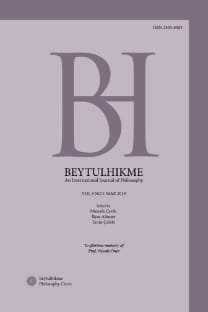Betimleyici Mantıklara Giriş
Yapay zekâ çalışmalarının merkezinde bulunan bilginin makinelerde nasıl temsil edileceği problemini çözmek için araştırmacılar doğal dile yakın ifade gücüne sahip ve berimsel karmaşıklıktan uzak formel sistemleri oluşturmaya odaklanır. Bu sistemlerden biri olan betimleyici mantıklar hem bilgisi sunulacak alanı iki ayrık yapıda -terminolojilerin ve alana ait özelleştirmelerin ayrı ayrı oluşturulduğu yapılarda- doğal dile yakın betimlemelerle sunar hem de karar verilebilir yapılarla alan bilgisini biçimselleştirirler. Berimsel ve ontolojik anlamda güçlü olan bu formel sistemlerin açık dünya varsayımını usavurmada uygulamaları, onlara sunulan enformasyon üzerinde farklı modeller üretebilme gücünü verir. Böylece betimleyici mantıklar ile oluşturulan sistemler yapay zekâ araştırmalarının en büyük hedeflerinden olan otomatikleştirilmiş bilgi çıkarımını destekleyecektir. Bu formel sistemlerin önemi ve kullanım alanı gün be gün artığından, amacımız hem felsefi mantık hem de ontoloji/bilgi mühendisliğine ilgi duyan sistematik felsefe araştırmacıları için betimleyici mantıklara bir giriş yapmak ve bu disiplineler arası araştırma alanını Türkçe olarak tanıtacak yazı dizisinin ilkini sunmaktır.
An Introduction to Description Logics
Being at the heart of artificial intelligence studies, the problem of how knowledge can be represented in machines focuses on constructing formal systems that have high expressive power close to natural language and that are far from computational complexity. One of these systems, the depiction logics not only represent the domain knowledge in two district structures that are close to the expressiveness of natural language but also formalize the domain knowledge in a decidable manner. These computationally and ontologically ro-bust formal systems apply open-world assumption in reasoning so that different models can be derived from the provided information. Designed for automated reasoning, one of the biggest ambitions of all time, the description logics gain importance day by day, then we aim to introduce description logics to the re-searchers in philosophical logic and to the researchers in systematic philosophy who are interested in ontology/knowledge engineering. Last but not least, this work is produced as the first of the articles to promote this interdisciplinary field in Turkish.
___
- Akçelik, O. (2016). Formel Ontoloji ve Betimleyici Mantıklar. VI. Mantık Çalışta-yı Kitabı. (Ed. V. Kamer & Ş. Ural). İstanbul: Mantık Derneği Yayınları, 17-24.
- Baader, F. & Calvanese, D. & McGuinness, D. & Nardi, D. & Patel-Schneider, P. F. (Ed.). (2007). Preface. The Description Logic Handbook: Theory, Implementa-tion, and Applications. Cambridge: Cambridge University Press, xv-xix.
- Baader, F. & Horrocks, I. & Lutz, C. & Sattler, U. (2017). An Introduction to Desc-ription Logic. Cambridge: Cambridge University Press.
- Baader, F. & Nutt, W. (2007). Basic Description Logics. The Description Logic Handbook. (Eds. F. Baader & D. Calvanese & D. McGuinness & D. Nardi & P. F. Patel-Schneider). Cambridge: Cambridge University Press, 47-104.
- Bergman, M. (2009). The Open World Assumption: Elephant in the Room. AI3:: Adaptive Information Blog. Yayınlanma Tarihi: 21 Aralık 2009. Erişim Adresi: http://www.mkbergman.com/wp-content/themes/ai3v2/files/2009Posts/Adaptivethe-open-world-assumption-elephant-in-the-room.pdf.
- Brachman, R. J. & Fikes, R. E. & Levesque, H. J. (1985). KRYPTON: A Functio-nal Approach to Knowledge Representation. Readings in Knowledge Represen-tation. (Eds. R. J. Brachman & H. J. Levesque). Burlington: Morgan Kauf-mann Publishers, 411-429.
- Grünberg, T. & Onart, A. & Grünberg, D. & Turan, H. (2003). Mantık Terimleri Sözlüğü. Ankara: METU Press.
- Guarino, N. (1995). Formal Ontology, Conceptual Analysis and Knowledge Representation. International Journal of Human-Computer Studies, 43 (5-6), 625-640.
- Horrocks, I. (2007). Implementation and Optimization Techniques. The Descrip-tion Logic Handbook. (Eds. F. Baader & D. Calvanese & D. McGuinness & D. Nardi & P. F. Patel-Schneider). Cambridge: Cambridge University Press, 329-373.
- Krötzsch, M. & Simancik, F. & Horrocks, I. (2012). A Description Logic Pri-mer. arXiv Preprint arXiv:1201.4089, 1-17.
- McGuinness, D. L. & Patel-Schneider, P. F. (2007). From Description Logic Provers to Knowledge Representation Systems. The Description Logic Hand-book. ((Eds. F. Baader & D. Calvanese & D. McGuinness & D. Nardi & P. F. Patel-Schneider). Cambridge: Cambridge University Press, 285-303.
- Möller, R. & Haarslev, V. (2007). Description Logic Systems. The Description Logic Handbook. (Eds. F. Baader & D. Calvanese & D. McGuinness & D. Nardi & P. F. Patel-Schneider). Cambridge: Cambridge University Press, 304-328.
- Nardi D. & Brachman, R. J. (2007). An Introduction to Description Logics. The Description Logic Handbook. (Eds. F. Baader & D. Calvanese & D. McGuin-ness & D. Nardi & P. F. Patel-Schneider). Cambridge: Cambridge University Press, 1-43.
- Sattler, U. & Calvanese, D. & Molitor, R. (2007). Relationship with Other For-malisms. The Description Logic Handbook. (Eds. F. Baader & D. Calvanese & D. McGuinness & D. Nardi & P. F. Patel-Schneider). Cambridge: Cambrid-ge University Press, 149-192.
- Shapiro, S. & Kouri Kissel, T. (2018). Classical Logic. The Stanford Encyclopedia of Philosophy. (Ed. Edward N. Zalta). Erişim Adresi: https://plato.stanford.edu/archives/spr2018/entries/logic-classical. Yargan, D. (2019). Formel Ontolojiler ve Betimleyici Mantıklar. Felsefe Arkivi, 51, 271-281.
- ISSN: 1303-8303
- Başlangıç: 2011
- Yayıncı: Mustafa Çevik
Sayıdaki Diğer Makaleler
Hüseyin Sadeddin Arel’in Denizaltında Felsefe Adlı Hikâyesinde Materyalizm-Spiritüalizm Tartışması
Platon Homeros'u Neden Sevmezdi?
Epiphenomenalism and the Causal Theory of Knowing
Felsefi Teolojide Antroposentrik Dönüş: Teolojik An-tropolojiye Bir Giriş
Ramhal'in Dinî ve Felsefî Öğretisinde İnsanoğlunun Hedefi
Sergii V. SOROKİN, Oksana GOLETS
The Problem of Human Purpose in Ramhal’s Religious and Philosophical Teaching
Sergii V. SOROKİN, Oksana GOLETS
Value-Normative Basis of Interaction of Civil Society and Legal State
VIACHESLAV BLIKHAR, Volodymyr ORTYNSKYİ, Nataliia ORTYNSKA, Mariana KASHCHUK
Scepticism and Platonic Inheritance: Did the Academic Skeptics Betray Plato?
